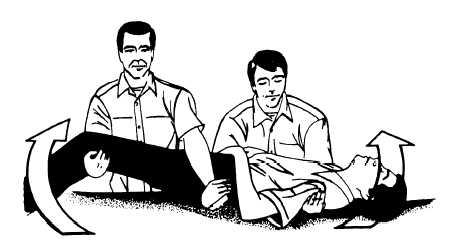also contain a wheeled litter, an Army litter, and both long and short spineboards. Supplies you may find include the following:

Figure 4-93 .—Two-person arm carry (alternate).
AIRWAYS.— Oropharyngeal airways come in sizes for adults, children, and infants. Their use was discussed earlier in this chapter. In addition, padded tongue blades or bite sticks for convulsive seizures, and tracheotomy tubes for victims with a tracheotomy will be provided.
ARTIFICIAL VENTILATION DEVICES.— Ambu-Bag (1 or 2) with masks of different sizes and oxygen enrichment capability.
SUCTION EQUIPMENT.— Portable and/or installed suction equipment for pharyngeal and tracheotomy suction, with tubes, tips, and collection bottles.
OXYGEN SUPPLY.— A portable unit with an extra cylinder and masks of different sizes.
HEMORRHAGE CONTROL.— Sterile gauze pads, battle dressings, soft self-adhering roller bandages, adhesive tape, safety pins, and bandage scissors.
SPLINTING SUPPLIES.— Various materials for upper and lower extremity splints, and triangular bandages.
SHOCK CONTROL.— Intravenous fluids in unbreakable containers, and administration kits, as determined by local directives.
BLOOD PRESSURE MONITORING.— Blood pressure cuff and stethoscope.
POISON RESPONSE.—Ipecac syrup in measured doses.
SPINEBOARD.— Long and short for spinal immobilization, extrication, and as a CPR surface. Deployed units at sea and in the field and certain commands near air stations will also have access to helicopter MEDEVAC support. Helicopters are ideal for use in isolated areas but are of limited practical use at night, in adverse weather, under certain tactical conditions, or in developed areas where building and power lines interfere. In addition to taking these factors into consideration, the corpsman must decide if the victim’s condition is serious enough, or too serious, to justify a call for the helicopter. Some injuries require very smooth transportation or are affected by the pressure changes incurred in flight. The final decision will be made by the unit commander, who is responsible for requesting the helicopter support.
Field operational units will have access to field ambulances, jeeps, and “gamma-goats” for casualty transportation. They have room for two to four Army litters and are used for behind the lines movement.
Care en Route
The emergency care a corpsman can offer patients en route is limited only by the availability
